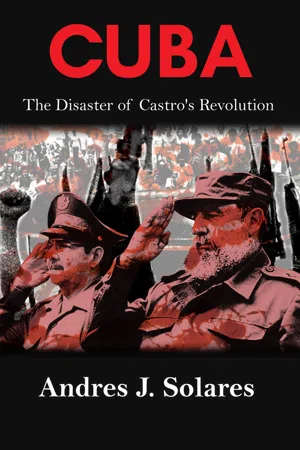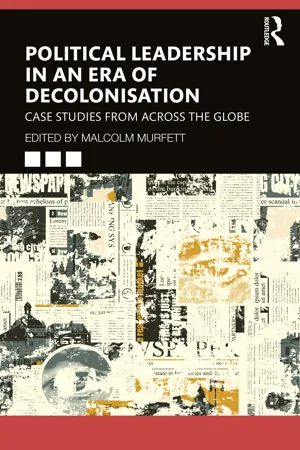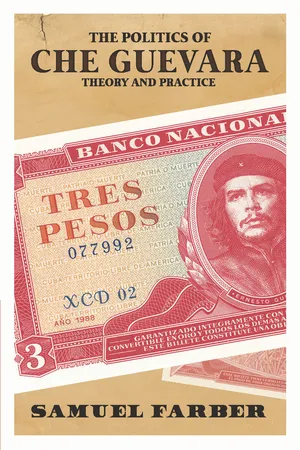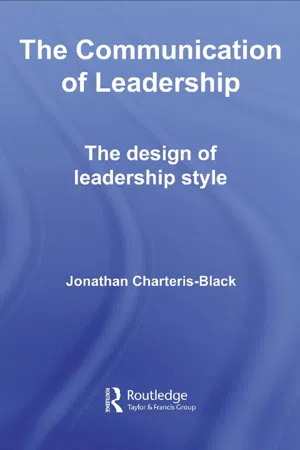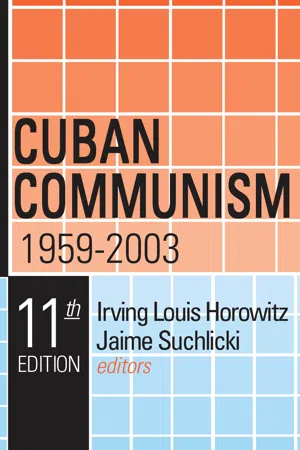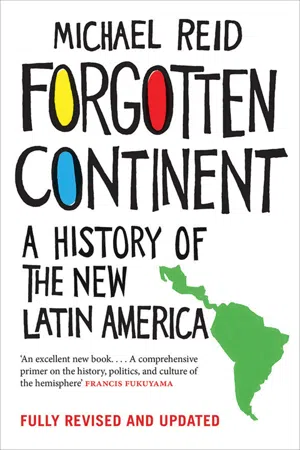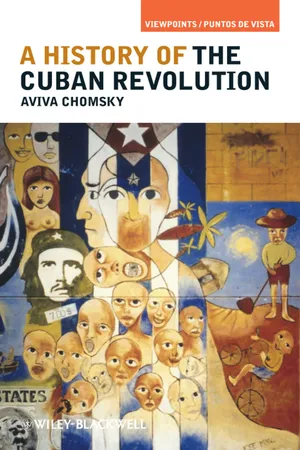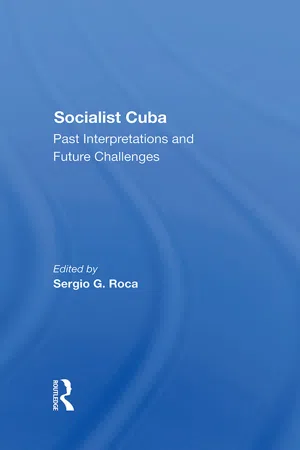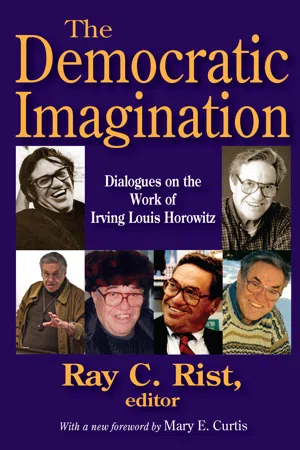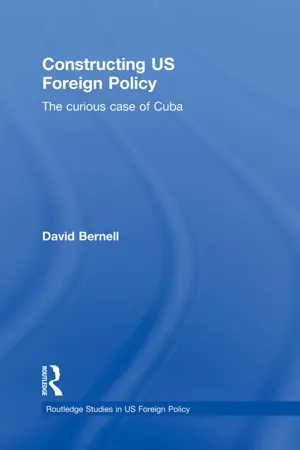Politics & International Relations
Fidel Castro
Fidel Castro was a Cuban revolutionary and politician who served as the Prime Minister and President of Cuba. He led the Cuban Revolution, overthrowing the government and establishing a socialist state. Castro's regime was marked by his strong anti-imperialist stance and close relationship with the Soviet Union, which led to tensions with the United States.
Written by Perlego with AI-assistance
12 Key excerpts on "Fidel Castro"
- eBook - ePub
- Andres Solares(Author)
- 2020(Publication Date)
- Global Summit House(Publisher)
Chapter XVCastro’s interpretation of foreign policy
The Cuban revolution was followed with extraordinary interest in all parts of the world since its early days, mainly because of the symbolic implications of having a small and powerless country confronting the most powerful nation on earth and it continued being a focus of attention after it transformed in a brutal dictatorship, something that has lasted to our days and Fidel Castro, being the main leader of this curious phenomenom, has received the attention not only of all levels of world politics, but also of those common people in many countries, who usually live their existence far from the great decisions and without involving at all in politics.Castro’s image and ideas, as well as his actions, have been followed, and in some extent magnified, by the international press, which has brought them to every corner of the world and this facilitated that he became a sensation of world politics, a sort of idol for friends and a demon for enemies, but always a connoted figure, with a very unique image.Castro tried hard to keep that status by doing eccentric political movements to attract attention and also by using his large propaganda machinery to this end. The result has been that, even now, after so many of his criminal actions have been exposed in detail by some of his former close allies, there are still many people around the world who feel an enormous fascination for him, no matter their political or ideological affiliation. - eBook - ePub
Political Leadership in an Era of Decolonisation
Case Studies from Across the Globe
- Malcolm Murfett, Malcolm Murfett(Authors)
- 2023(Publication Date)
- Routledge(Publisher)
3 Fidel Castro The eternal leader of a revolution or the leader of an eternal revolution? Vinicius Mariano de CarvalhoDOI: 10.4324/9781003426165-3Condemn me, it doesn’t matter, history will absolve me.(Fidel Castro’s statement in his trial for the attack on the Moncada barracks, on 16 October 1953)*Introduction
It may seem a little strange to start a chapter for an academic book talking about oneself. Especially because this is not a chapter about myself or my theories or academic thoughts, rather it is a chapter about a global leader who left a huge impact on generations both during and after the Cold War. My chapter is about Fidel Castro (1926–2016), but to introduce the character, I may need a small autobiographic digression.For a young boy, born during a right-wing military dictatorship (1964–1985) in Brazil, one among several that were in place in many Latin American countries, growing up in poverty in a socially unequal society, under political repression, disappearances, tortures, and death, merely developing political consciousness was already an act of rebellion. Grassroots movements, like workers’ unions, students’ unions, and social movements, had a strong role in this process of political education. Even the Catholic Church became a powerful space for political resistance, thanks to the Theology of Liberation being practised in the region since the early 1960s. As every teenager around the world, we were also searching for our idols, our exemplary figures. Besides the traditional rock stars or famous actors, for many of my generation, we also had our political idols. And in Latin America, undoubtedly, those would be Che Guevara and Fidel Castro. At that time, Che Guevara was already dead, killed in the jungles of Bolivia in 1967, fighting another Quixotesque guerrilla war. The one alive and sound was Fidel Castro. My political engagement during my youth was strongly impacted by this controversial leader that on one side was seen as the only one in Latin America who managed to not only win a revolution but also establish a regime against American imperialism; who survived several botched assassination bids by the CIA; that from a small and poor island, continuously challenged the predatory capitalist model implanted in the Latin American region. Of course, I was aware of the other side of this history, such as the executions of political opponents – described as traitors of the revolution –, the repression to the GLBTQ+ on the island, the restriction of the press, and other repressive actions of Fidel Castro. However, the simple fact that he managed to break the path of US imperialism in the region was enough for propelling him into an iconic position. So, on the walls of my bedroom, instead of posters of singers and actors or actresses, I had on one side Che Guevarra and on the other Fidel Castro. Overlaid on both posters were quotations of some of their speeches. - eBook - ePub
The Politics of Che Guevara
Theory and Practice
- Samuel Farber(Author)
- 2016(Publication Date)
- Haymarket Books(Publisher)
Chapter Three Che Guevara in PowerIt is striking that Che Guevara’s status as an international icon is almost entirely based on his militant activities and writings as an international guerrilla fighter in Cuba, the Congo, and Bolivia. Yet, one could make a strong argument that his most important and consequential political legacy was the major role he played as one of the principal leaders of the Cuban Revolution, building a new socioeconomic and political system on the island, thus shaping the future of Cuba for generations to come.When Batista was overthrown on January 1, 1959, Fidel Castro had already emerged as the dominant leader of the July 26th revolutionary movement. Right behind him, Che Guevara was, along with Camilo Cienfuegos and Raúl Castro, one of the three other principal leaders of the rebel army, and certainly the most politically and culturally sophisticated of the three. Although a special revolutionary law had made Guevara a citizen with the same rights as a native Cuban, this did not entirely remove the subtle but real political disadvantage of his being a foreigner. His cold and distant personality, in some ways similar to Raúl Castro’s, encouraged a great deal of popular respect and even awe, but not love, and certainly not the popular adoration bestowed on Fidel Castro and Camilo Cienfuegos. With his slight physical resemblance to popular representations of Jesus Christ and Camilo’s urban working-class background, Cienfuegos represented to the Cuban people the ideal virtues of a warm demeanor, good humor, and good looks. - eBook - ePub
Back From the Future
Cuba Under Castro
- Susan Eva Eckstein(Author)
- 2004(Publication Date)
- Routledge(Publisher)
Although leadership is not bound in its action by the principles it espouses, those principles may affect the range of options considered. The principles, in turn, may generate their own contradictions or problems. Moral commitments may, for example, induce persons in authority to implement policies, such as social programs, that conflict with their fiscal concerns. The moral principles elites advance may also generate expectations they do not or cannot fulfill. The failure of leadership to practice what it preaches may make folk cynical, angry, and disobedient. And publicly proclaimed principles may be interpreted in ways the propagators did not intend. Abroad, for example, the anti-Communist world has responded more to the rhetoric than to the reality of Marxist- Leninist states. With respect to Cuba this became particularly apparent in the latter 1980s. The U.S. government, and the U.S. media in turn, took (or chose to take) at face value the stepped-up ideological orthodoxy associated with the official campaign to “rectify errors and negative tendencies”; this stood in the way of any “normalization” of U.S.-Cuban relations, even though Castro at the time was making increased concessions to foreign capital and initiating market reforms.The complex possible relationships between ideology and social structure give reason to believe that Marxist-Leninist-legitimated regimes may have been less ideologically driven over the years than portrayed in studies of Communism. In the chapters that follow, ideological rationales for economic and social policies will be described, but their policy-determining role will not be assumed a priori.THE HISTORICAL ROOTS OF THE CUBAN
REVOLUTION If Castro’s use of power is circumscribed by history and if Castro himself is a by-product of the country’s historical heritage, prerevolutionary conditions help explain revolutionary dynamics. Castro’s triumphal rise to power, on January 1, 1959, followed decades of political conflicts, violence, and instability.Cuba’s political independence, which came only at the end of the nineteenth century, involved a struggle that took on a radical and anti-imperialist character. José Martí is considered the hero of the nationalist struggle. After independence Cuba’s upper classes were unable to maintain political order. No political party or group of parties held on to power for a sustained period of time. Although the island briefly experienced constitutional democracy in the immediate post-World War II period, caudillos - eBook - ePub
The Communication of Leadership
The Design of Leadership Style
- Jonathan Charteris-Black(Author)
- 2006(Publication Date)
- Routledge(Publisher)
6 Fidel Castro The Cuban Robin HoodIntroduction
The image of Fidel Castro – a big man with an unkempt beard wearing a peaked khaki cap and coarse military fatigues has become – along with those of Lenin, Mao, Che Guevara and Mao Tse-tung – a major global icon of communism. The fact that he is still a leader in the first decade of the twenty-first century is a prodigious feat of leadership skill. By 1962 the Cuban leader had already spent several years in exile, led a successful socialist rebellion, and fought off a US-sponsored invasion; since then he has resisted numerous assassination attempts and proven to be the greatest of political survivors. Though originally a pawn in a superpower struggle for global domination, since the collapse of the Soviet Union he has become a dramatic symbol of the moral courage of smaller nations in their struggle for survival as independent entities against usually aggressive and expansionist neighbours.We may well ask how it is that the leader of a small island with a population of around ten million is still a thorn in the side of the most powerful nation in human history. In this chapter I propose that this is because he has designed a leadership style in which he identifies himself with Cuban national aspirations and these, in turn, have come to symbolize the cause of underdogs everywhere. This communication strategy – like that of Mandela and Gandhi – establishes an ethical legitimacy through adopting the cause of the underprivileged in societies dominated by apparently powerful and immoral forces; this satisfies the deep unconscious needs of followers for a heroic leader. - eBook - ePub
- Irving Louis Horowitz(Author)
- 2018(Publication Date)
- Routledge(Publisher)
Since becoming the leader of Cuba, one of Castro’s main objectives has been to undermine U.S. power and prestige in the world. His support of anti-American guerrillas and terrorists in Latin America in the 1960s and 1970s, his military involvement with and support for anti-American regimes and groups in Africa and the Middle East in the 1970s and 1980s, and his constant denunciations of “U.S. imperialism,” “capitalism,” and “neo-liberalism” in international organizations and forums attest to his determination and consistency.Castro sees anti-Americanism, as well as his commitment to violence, as the main contributions of his revolution and leadership. Little does he care that his beliefs and actions remain a Communist project undertaken in stark isolation from and opposition to the course of history in the Americas-and for that matter, the rest of the contemporary world.The following selected statements by Castro over the last four decades clearly show his consistent anti-Americanism and his belief in the eventual success of Communism over capitalism even after the collapse of the Soviet Union and the Communist camp. History reveals instances when strong and even autocratic leaders have mellowed with age and softened their positions, but there is scant evidence that this is the case with Castro.On the contrary, as the Cuban leader has aged he has become more intransigent and difficult. At the 1997 Communist Party Congress in Havana, he reaffirmed his staunch opposition to the U.S. and his unwillingness to relinquish power. After the congress he gathered international friends and allies to exhort them to prepare for the eventual failure of capitalism and the rise of communism. - Jaime SuchlickiFidel Castro on the United States, 1958-2003
1958 When this war is over a much wider and bigger war will commence for me: the war I am going to wage against them [the United States]. I am aware that this is my true destiny.We accuse the U.S. government...of selling to the Batista dictatorship the planes and bombs that have killed so many defenseless Cuban civilians. If the U.S. violates our sovereignty we will defend it with dignity.. We are ready to die in defense of our people. - Michael Reid(Author)
- 2017(Publication Date)
- Yale University Press(Publisher)
36The evidence suggests that those who have argued that Castro was somehow pushed into the arms of the Soviet Union and communism by the American economic embargo imposed, in stages, in 1960–62 are mistaken. The Cuban government’s decisions were of its own volition.37 It is safe to say that two political impulses drove Fidel Castro. The first was Cuban nationalism and anti-Americanism: he was determined to end US influence over the island’s affairs. The other was the permanence of his revolution and of his personal control over his country.38 Communism provided the tools to satisfy both impulses, rather than being an end in itself. Fidel always claimed primary inspiration from Martí – the nationalist, anti-imperialist Martí, rather than the democrat – not Marx. ‘The intellectual author of this revolution is José Martí, the apostle of our independence’, he said at the Moncada trial in 1953.39It may not be coincidental that in both Cuba and Mexico revolutions whose aims included the consolidation of the nation state in the face of what was perceived to be a threat from the United States led to the establishment of one-party regimes. Yet democracy is far from incompatible with national self-determination, as many other countries have demonstrated. Castro drew on Cuba’s traditions of guerrilla warfare and revolutionary violence, and its long struggles for nationhood and racial and social justice. The extent to which he came to embody that struggle explained the affection and respect many Cubans held for him despite their privations. But Fidel was also a Latin American caudillo, who militarised Cuban society as never before and ruthlessly crushed dissent. Especially in the 1960s, he incarcerated tens of thousands of political prisoners, often under appalling conditions – for much longer than would have been the case under the most repressive of South American dictators, as Jorge Domínguez, a Cuban–American political scientist, has pointed out.40- eBook - ePub
- Aviva Chomsky(Author)
- 2010(Publication Date)
- Wiley-Blackwell(Publisher)
Introduction Rarely does popular opinion in the United States diverge so strikingly from scholarly analysis as in the case of the Cuban Revolution.It’s one of the few events in Latin American history that U.S. students have heard of. When I ask my students to come up with names of important figures in Latin American history, the only one that reliably emerges is that of Fidel Castro. And students are fairly unanimous in their opinions of Castro: “Dangerous,” “evil,” “bad,” and “dictator” are the words they most commonly come up with to describe him. Survey results show that my students’ positions are widely shared among the U.S. population: 98 percent of those surveyed in the United States had heard of Fidel Castro, and 82 percent had a negative opinion of him.1Fidel Castro has certainly inspired his share of scholarly attention, including numerous biographies. Some are by historians. Some are by journalists. One is by a doctor. There is even a graphic novel recounting Fidel’s life. In a “spoken autobiography” the Cuban revolutionary recounted his own story of his life.2Most serious studies of the Cuban Revolution, though, focus less on the figure of Fidel Castro and more on the process, the politics, and the people of the Cuban Revolution. Here we find a giant gap between what scholars, including historians, have to say, and what U.S. political leaders and the general public seem to believe. Most historians frame the story of the Cuban Revolution with the long history of U.S. involvement in the island and in the rest of the Caribbean. But politicians and the general public have tended to see the USSR, rather than the United States, as the main factor explaining the nature of the Cuban Revolution. In this respect, U.S. scholars today have more in common with their Cuban counterparts than they do with the U.S. public. - eBook - ePub
Socialist Cuba
Past Interpretations And Future Challenges
- Sergio G Roca, Rhoda Rabkin, Sergio Diaz-Briquets, Carmelo Mesa-Lago(Authors)
- 2019(Publication Date)
- Routledge(Publisher)
Imagine, if you will, that you have been granted the privilege of sitting in during a meeting of the Cuban Communist Party's (PCC) Politburo at which Cuba's foreign relations are being discussed and assessed. As you sit there, you will be struck by the group's homogeneity and by the fact that its composition has changed since you last observed these men back in 1975. The Castro brothers, particularly President Fidel Castro, dominate the discussion and seldom face challenges from the other thirteen comrades, including his sister-in-law Vilma Espin. Invariably, you will be impressed by the vehemence of President Castro's arguments, by the knowledge and experience which he brings to the discussion, and by the sheer force of his legendary personality.The discussion ranges far and wide, and it touches on subjects like the summit between President Reagan and General Secretary Gorbachev; the performance of Cuba's troops in Angola, engaged in actions against Jonas Savimbi's UNITA (National Union for the Total Liberation of Angola) guerrillas; the Sandinistas' crackdown on their legitimate opponents and the regional consequences of those measures; Latin America's failure to rally around President Castro's call for a united repudiation of the area's external debt; and on the changes announced during the Communist Party's Third Congress. The meeting is tense because the regime faces major domestic difficulties, but its foreign relations for the most part are thought to be solid and productive. Imperialist threats are always present, President Castro reminds his colleagues, but Cuba is a strong country, indeed nearly invulnerable. One must still emphasize production and defense, and make sure that everyone is ready and alert, just in case the enemy misreads our strength and will. The Party is our vanguard and "the war of all the people" will be waged with implacable tenacity at home and abroad. With that admonition ringing in their ears, the members file out in good spirits and you are left to wonder what— if any—doubts and suspicions they silenty hold. - eBook - ePub
The Democratic Imagination
Dialogues on the Work of Irving Louis Horowitz
- Louis Filler(Author)
- 2017(Publication Date)
- Routledge(Publisher)
Stalinization was the topic of Horowitz’s first essay on Cuba, published in 1965 and updated in 1971. According to him, between 1966 and 1969, Castro’s statements and policies bore the contention that he accepted the premises of Stalinism. This was mainly a result of Castro’s own personality but was exacerbated by the hostile U.S. policy against the island, which provided the milieu for such negative features to flourish (Horowitz, 1965, 1977a). To prove his hypothesis, Horowitz pinpointed several common features of Castro’s Cuba and Stalin’s Soviet Union:- The shift to left wing domestic nationalism: the survival of the revolution in both countries required its consolidation and development at home at the price of abandoning revolution abroad. In addition, Castro’s attitude toward other revolutionaries in Latin America also resembled Stalin’s: patronizing when they agreed with him and censorious when they did not.
- The bureaucratization of the Cuban Communist party (PCC) personally controlled by Castro who became the party’s exclusive spokesman and also concentrated the top positions in the government and the army, as well as the subordination of society to the party state and this, in turn, to Castro.
- The politics of purge, dismemberment of any possible opposition, elimination of politico-economic debate and socialist democracy (both subordinated to a single developmental strategy set by Castro) and the militarization of society and institutions including the party.
- The removal of the heads of the right and left wings of the revolution and the centralization of control by the Maximum leader: in Cuba the dismissal of pro-Soviet economist Carlos Rafael Rodriguez and the departure of Guevara—Cuba’s Trotsky—in the mid-1960s.
- The surrounding of the revolutionary state by powerful hostile forces (the United States in the Cuban case) and the impossibility of normalizing trade with the capitalist bloc; these two factors provided a rationale for the inward concentration on development and defense, as well as the repressive measures.
- The politics of massive labor mobilization of a military type in both countries (toward industry in the Soviet Union and sugar in Cuba) regardless of their economic costs and consequences.
- Finally, Castro’s attack on and break with China in 1966, which took place at the same time that Soviet ideologists were resuming their condemnation of both Trotskyism and the need for permanent revolution (an idea then supported by the Chinese leadership) while arguing that the peaceful coexistence strategy did not imply capitulation.
- eBook - ePub
Voice in Political Discourse
Castro, Chavez, Bush and their Strategic Use of Language
- Antonio Reyes(Author)
- 2011(Publication Date)
- Continuum(Publisher)
Perhaps the most noticeable and longest-lasting opposition that the U.S. neo-liberal policies have had in Latin America is Cuba. The political landscape has been quickly transformed under the influence of new leaders like Hugo Chávez in Venezuela and Evo Morales in Bolivia, who presented new threats to established political economic control of the region by George W. Bush and his cohort. Socialism is now growing in strength in Latin America (Castañeda 2006; Fuentes 2006).(1) There is a leftward drift in Latin America today, but it is not homogeneous. Those parties of the leaders of the left who spring from an old Communist, Socialist or Castroist tradition (with the exception of Castro himself) tend to have crossed the Rubicon to market economics, representative democracy, respect for human rights and a responsible geopolitical stance. Belonging to this crowd are Chile’s Ricardo Lagos and his successor, Michelle Bachelet; Brazil’s Luiz Inacio Lula da Silva; and even perhaps Uruguay’s Tabaré Vázquez. But those whose roots plunge deep into the Latin American populist tradition, like Venezuela’s Hugo Chávez, Argentina’s Nestor Kirchner, and Bolivia’s Evo Morales, are of a different strain (Castañeda 2006: 59).This phenomenon has grown parallel to the war on terror derived from the events of September 11 2001, which have reshaped the global political landscape. Erikson (2004) suggests that:(2) Ironically, Castro has principally Washington to thank for Cuba’s rejuvenated ties with Latin America. Since 9/11, the focus on the ‘war on terror’ has led Washington to neglect hemispheric relations. At the same time, the U.S. invasion of Iraq was highly unpopular in the region. Castro, highly attuned to shifts in the political wind, has seized on the widespread disapproval of Washington’s approach to the ‘war on terror’ to attempt to renew political and economic partnerships in the region (Erikson 2004: 33).The ties among countries are being reinforced with bilateral and multilateral agreements. For example: - eBook - ePub
- David Bernell(Author)
- 2012(Publication Date)
- Routledge(Publisher)
Until Raúl Castro’s ascent to the top spot, the country had been described by the US State Department as, “a totalitarian state dominated by Fidel Castro. . . [who] exercises control over nearly all aspects of Cuban life.” “To an extent almost unique in world politics,” it is established, “the Cuban state is dominated by one person.” 27 Current assessments say instead that, “Cuba is a totalitarian communist state headed by General Raúl Castro and a cadre of party loyalists. Castro replaced his brother Fidel Castro as chief of state, president of Cuba, and commander-in-chief of the armed forces on February 24, 2008. Fidel Castro retains the position of First Secretary of the Cuban Communist Party (PCC)... Cuba’s government controls all aspects of life through the Communist Party and its affiliated mass organizations.” 28 The government has maintained control by using “a network of directorates,” most notably, the ministry of the interior, which “ensures political and social conformity as well as internal security, [and] maintains pervasive vigilance through a network of informers and 80,000 block committees.” 29 Or, more pointedly, in the words of President George H.W. Bush, “he [Castro] is a dictator, a totalitarian dictator.” 30 All else is seen to follow from that, from the country’s domestic and foreign policies, to the US responses which are said to necessarily result from such provocations. After all, as a succession of post-Cold War presidents have stated, the problem between the US and Cuba continues to be Castro’s refusal to change, not the United States’. 31 In this understanding the illegitimacy of the Cuban government is self-evident, as is the need to bring about its demise. If “ten million of our neighbors have withstood three decades of a one-man, one-party state,” then “that is a tragedy which must end.” 32 No other reasons need to be provided in order to justify US action. Or as President George W. Bush said, “We love freedom
Index pages curate the most relevant extracts from our library of academic textbooks. They’ve been created using an in-house natural language model (NLM), each adding context and meaning to key research topics.
Explore more topic indexes
Explore more topic indexes
1 of 6
Explore more topic indexes
1 of 4
